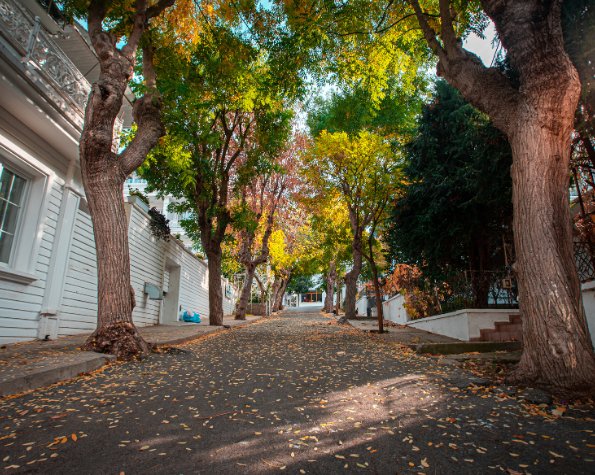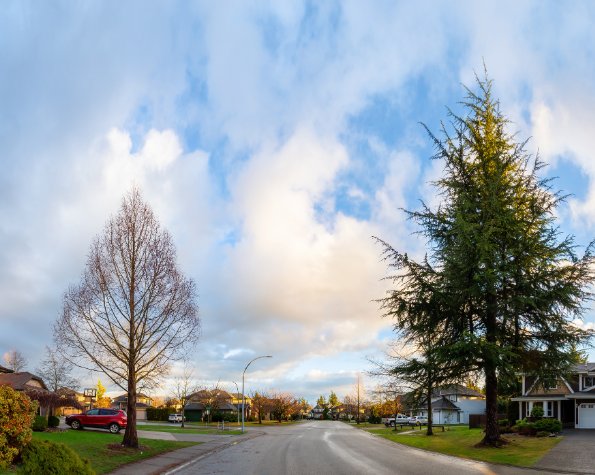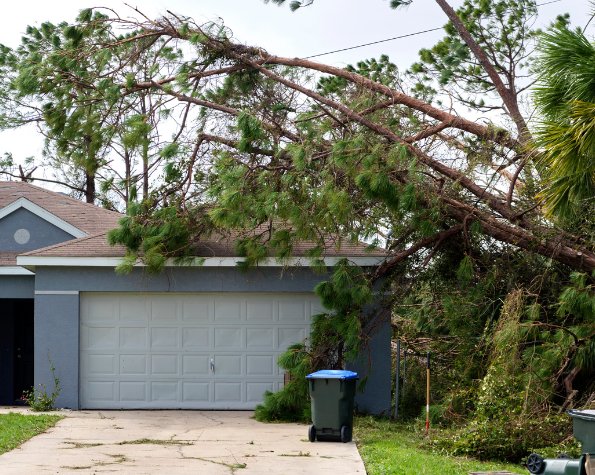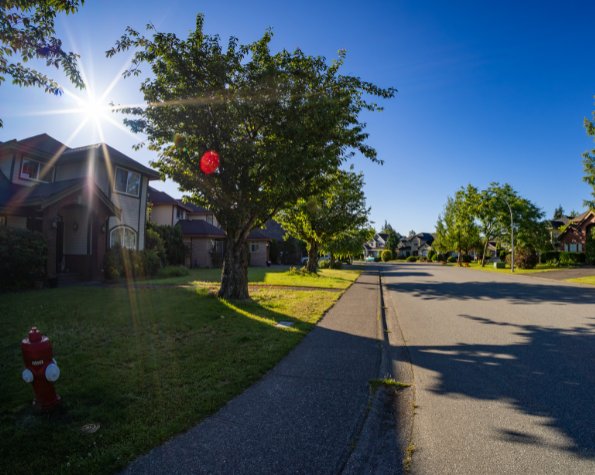NASSAU
How Close Can a Tree Be to My House?
Tree roots or a tree that’s too close to your home or fence are problems for a lot of reasons. It’s about safety, damage, and what happens when things go wrong. There are different causes, different risks, and different ways to handle it, but it all comes down to one thing.
Is a tree close to my home safe? How close is too close? Can tree roots damage your foundation? Will it interfere with your fence or roof? The answers all depend on the size of the tree, its proximity, its behaviour, and any signs of stress on your house.

Signs Your Tree Is Too Close to Your House or Fence
- Tree branches are touching or rubbing the exterior of your house
- Roots are lifting or cracking the foundation or basement wall
- Leaves and debris clog your gutters
- The trunk is within 10 feet of your house or fence
- Tree canopy overhangs your roof or chimney
- Roots are growing under your fence
- You hear scraping or tapping sounds from branches
- Moisture builds up on the siding
- Mushrooms or fungus are growing at the base of the tree near the house
- The tree is a large species (oak, sycamore, maple) planted within 15 feet of a structure
- The tree was planted before the house or fence, and now they’re too close
- Neighbors have raised concerns about the tree’s proximity to property lines
- The tree leans toward your house
- You’ve had to repair siding, gutters, or the roof due to tree contact

How Far Should a Tree Be From Your House?
Small Trees (15–25 ft at maturity)
Trees like Japanese maple or serviceberry, a distance of 8–10 feet from the house is usually safe. They have smaller root systems and less canopy weight.
Medium trees (30–50 ft)
For the red maple or hornbeam, stay 15–20 feet away. Their roots can spread 2–3 times the width of the canopy, and their branches can damage roofs and gutters.
For large trees (60+ ft)
For pin oak, sycamore, or tulip trees, the minimum distance should be 25–30 feet. These trees have massive root systems and heavy limbs that can cause serious damage in a storm.
How Far Should a Tree Be From a Fence?
Fences are more forgiving than houses, but trees can still cause problems if planted too close.
For privacy or wooden fences, keep trees at least 6–8 feet away. Roots can warp, lift, or rot fence posts, especially in clay-heavy NY soil. Branches can also weaken the structure over time.
For chain-link or vinyl fences, you can go slightly closer – 4–6 feet – but only with small or slow-growing species. Fast-growing trees like silver maple or willow will eventually compromise any fence.
If you’re planting a new tree near a fence, consider its mature width and root spread. A tree that’s 3 feet from the fence now could be 15 feet wide in 20 years.

Risks of a Tree Too Close To a House

Foundation Stress from Root Pressure
While tree roots don’t typically crack solid concrete slabs, they can find and exploit existing weaknesses, especially in older homes with stone, brick, or block foundations common in Brooklyn, Queens, and Nassau County. In clay-heavy NY soil that expands and contracts with freeze-thaw cycles, which happens all the time in NYC, roots can worsen small cracks over time.

Roof and Siding Damage from Branches
Another major risk is roof and siding damage from constant branch contact. When limbs rub against shingles, they wear down the protective granules (the little pieces on top of shingles), which can shorten the roof’s lifespan. Siding, especially vinyl or wood, gets scratched or dented. And during storms, heavy tree limbs can break off and cause damage immediately. Even if the tree doesn’t fall, this ongoing friction weakens your home’s exterior.

Pest Entry Points
Close trees also create pest entry points. Squirrels, raccoons, rats, and insects use overhanging branches like highways into your attic, soffits, and crawl spaces. (For real). A limb touching the roof gives them direct access.

Storm Hazard
In extreme weather, a nearby tree becomes a storm hazard. If it’s within 10–15 feet of your house, wind, snow, or ice can push it into your roof, garage, or deck. A falling tree can collapse walls, destroy windows, or knock out power lines. Even if insurance covers the repair, the danger potential is very real. And if the tree was visibly unhealthy or leaning, your claim could be denied due to negligence.
Can You Plant a Tree Near a House or Fence Safely?
Yes, if the tree is small and you plan ahead, you can safely plant a small tree near your home or fence.
Choose the Right Tree Species
If you’re planting near your house or fence, go with species like Japanese maple, redbud, serviceberry, hornbeam, or kousa dogwood. These mature at a manageable size and won’t threaten your structure. Avoid high-risk trees like silver maple, willow, poplar, or Bradford pear. They’re prone to disease, weak wood, and invasive roots.
Plant at a Safe Distance
Use the DBH x 3.5 rule: multiply the tree’s mature trunk diameter by 3.5 to estimate how far its roots will spread. For example, a tree with a 20-inch mature trunk should be planted at least 6 feet away. Small trees can be closer, 8–10 feet. Medium trees need 15–20 feet. Large trees need 25–30 feet.
Install Root Barriers During Planting
These durable panels (made of plastic or composite material) are placed between the tree and the house to guide roots downward, away from structures. They work best when used at planting time, so roots adapt to growing below grade instead of pushing toward your basement wall.
Avoid Large Trees Near Structures
Sounds obvious, but it’s the best way to avoid harm. The roots of a mature oak, sycamore, or tulip tree can extend 70+ feet from the trunk. Limbs can rub against siding, wear down shingles, or fall in a storm. If you want a large tree, plant it in the backyard or the center of a wide front yard.
When Removal Is the Right Choice
If a tree is already too close to your house and showing signs of risk, lean, decay, root damage, or structural interference, fully removing the tree may be the safest option.
A tree that’s 5 feet from your house is inconvenient, but more importantly, a liability. It can fall, drop limbs, or cause foundation issues. We don’t push removal if it’s not what is best for tree or your safety. But when it’s the smartest, safest move, we say it. And we do it cleanly, with no damage to your property.

FAQs
Tree roots don’t usually crack solid concrete foundations, but they can exploit existing cracks or cause heaving in older homes with stone, brick, or block walls. In New York City, where freeze-thaw cycles and clay soil are common, roots can worsen drainage issues and lead to water intrusion. If you have a tree within 10 feet of your foundation and you’re seeing cracks or moisture in the basement, it’s worth having us assess the situation. In some cases, root pruning or removal is the best way to protect your home.
You can plant a tree right up to the property line, but it’s not always wise. If the tree grows into your neighbor’s yard, they have the right to trim branches up to the line, but not to cross it. If roots damage their fence or yard, you could be held liable. To avoid disputes, we recommend planting large trees at least 10–15 feet from the property line, and medium trees 6–8 feet away.
If the tree is healthy and not causing damage, it might be fine with regular maintenance like pruning, gutter cleaning, and inspections. But if it’s leaning, has dead branches, or roots are lifting the foundation, it could be a risk. We’ll evaluate the tree’s health, root spread, and storm vulnerability. If the risk is high, removal may be the safest long-term solution.
If a tree is actively rubbing against your fence, it’s causing damage, and likely will continue to. Light contact might be manageable with pruning, but constant pressure warps posts, splits wood, and accelerates rot. For small trees, trimming may help. For large, mature trees, removal is often the smarter choice.
Homeowners insurance often covers sudden damage, like a fallen limb breaking a window, but not gradual issues caused by a tree growing too close. If roots crack your foundation or branches wear down your roof over the years, that’s typically considered maintenance, not a claimable loss. And if the tree was clearly unhealthy or leaning, your claim could be denied. That’s why we recommend acting early.
You can, but it’s risky. Adding weight and compacting soil around the base stresses the roots. Covering the root zone with decking suffocates them. And if the tree ever needs to be removed, taking out a deck built around it becomes a major project. If you’re planning construction, have us evaluate the tree before you build.
No, it’s a serious safety issue. Trees growing into power lines can cause outages, fires, or electrocution risks. Utility companies trim these trees on a schedule, but that weakens the tree over time. If a large limb breaks during a storm, it can take the line down with it. In most cases, if a tree is within 15 feet of overhead lines, it should be removed especially if it’s fast-growing or prone to disease.
CONTACT GREENLEAF TODAY!
We’ve been helping NYC homeowners assess trees too close to homes, fences, and structures for over 40 years. We’ll come to your yard, inspect the tree and its proximity to your property, and tell you what’s really going on so you can make a safe, informed decision.
